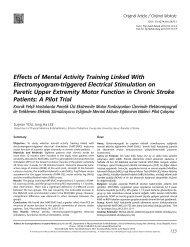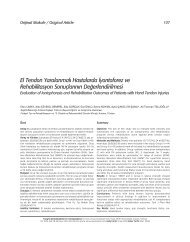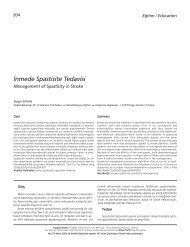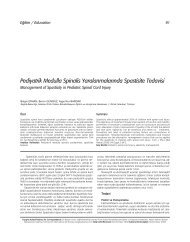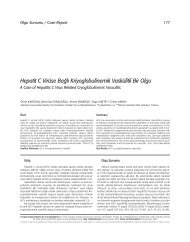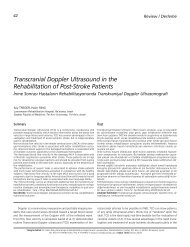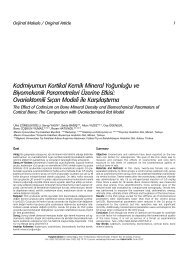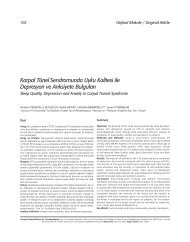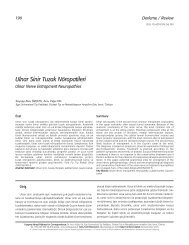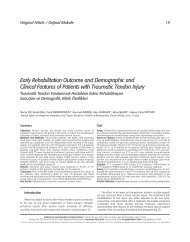Effects of Functional Electrical Stimulation on Wrist ... - FTR Dergisi
Effects of Functional Electrical Stimulation on Wrist ... - FTR Dergisi
Effects of Functional Electrical Stimulation on Wrist ... - FTR Dergisi
Create successful ePaper yourself
Turn your PDF publications into a flip-book with our unique Google optimized e-Paper software.
<str<strong>on</strong>g>Effects</str<strong>on</strong>g> <str<strong>on</strong>g>of</str<strong>on</strong>g> <str<strong>on</strong>g>Functi<strong>on</strong>al</str<strong>on</strong>g> <str<strong>on</strong>g>Electrical</str<strong>on</strong>g> <str<strong>on</strong>g>Stimulati<strong>on</strong></str<strong>on</strong>g> <strong>on</strong> <strong>Wrist</strong><br />
Functi<strong>on</strong> and Spasticity in Stroke: A Randomized<br />
C<strong>on</strong>trolled Study<br />
İnmede F<strong>on</strong>ksiy<strong>on</strong>el Elektrik Stimülasy<strong>on</strong>unun El Bileği F<strong>on</strong>ksiy<strong>on</strong>ları ve Spastisiteye<br />
Etkisi: Randomize K<strong>on</strong>trollü Bir Çalışma<br />
Sum mary<br />
Objective: To investigate the effect <str<strong>on</strong>g>of</str<strong>on</strong>g> functi<strong>on</strong>al electrical stimulati<strong>on</strong> <strong>on</strong><br />
wrist functi<strong>on</strong> and spasticity in individuals with subacute/chr<strong>on</strong>ic stroke.<br />
Materials and Methods: Randomized, c<strong>on</strong>trolled and prospective<br />
study. Twenty-eight patients with a mean age <str<strong>on</strong>g>of</str<strong>on</strong>g> 58.9±12.3 years and<br />
with a mean stroke durati<strong>on</strong> <str<strong>on</strong>g>of</str<strong>on</strong>g> 100±62 days were randomly assigned to<br />
a functi<strong>on</strong>al electrical stimulati<strong>on</strong> group or a c<strong>on</strong>trol group. A standard<br />
rehabilitati<strong>on</strong> program was applied to c<strong>on</strong>trol group (n=14), and a<br />
standard rehabilitati<strong>on</strong> program plus functi<strong>on</strong>al electrical stimulati<strong>on</strong><br />
<str<strong>on</strong>g>of</str<strong>on</strong>g> wrist and finger extensors were applied to the other group (n=14).<br />
Upper limb functi<strong>on</strong> was assessed by the Motricity index and spasticity<br />
was assessed by the Ashworth scale at the beginning and two weeks after<br />
the treatment. Resistance to passive wrist flexi<strong>on</strong> and extensi<strong>on</strong> at 60,<br />
90 and 120 degrees/sec velocities were measured by using an isokinetic<br />
dynamometer.<br />
Results: Total upper extremity Motricity index scores were not different<br />
between the groups at the beginning (p=0.142). Intragroup analyses<br />
<str<strong>on</strong>g>of</str<strong>on</strong>g> the Motricity index showed that there was a statistically significant<br />
improvement in total Motricity index score in functi<strong>on</strong>al electrical<br />
stimulati<strong>on</strong> group (n=14) (p=0.027), however, other studied parameters<br />
did not improve significantly (p>0.05). N<strong>on</strong>e <str<strong>on</strong>g>of</str<strong>on</strong>g> the studied parameters<br />
statistically significantly improved in the standard rehabilitati<strong>on</strong> group<br />
(n=14) (p>0.05).<br />
C<strong>on</strong>clusi<strong>on</strong>: Adding functi<strong>on</strong>al electrical stimulati<strong>on</strong> to standard<br />
rehabilitati<strong>on</strong> program has a positive improving effect <strong>on</strong> the upper limb<br />
motor functi<strong>on</strong> in patients with post-stroke hemiplegia. Turk J Phys Med<br />
Rehab 2013;59:97-102.<br />
Key Words:Stroke, functi<strong>on</strong>al electrical stimulati<strong>on</strong>, spasticity<br />
Özet<br />
Original Article / Orijinal Makale<br />
DO I: 10.4274/tftr.67442<br />
Turk J Phys Med Re hab 2013;59:97-102<br />
Türk Fiz T›p Re hab Derg 2013;59:97-102<br />
dilek KaraKuş, Murat erSÖz, Gönül kOyuncu, dilek Türk, Fatma Münevver şaşmaz, Müfit akyüz<br />
Ankara Physical Medicine and Rehabilitati<strong>on</strong> Training and Research Hospital, Ankara, Turkey<br />
Amaç: Subakut/ kr<strong>on</strong>ik inmelilerde f<strong>on</strong>ksiy<strong>on</strong>el elektrik stimülasy<strong>on</strong>unun<br />
el bileği f<strong>on</strong>ksiy<strong>on</strong>ları ve spastisitesine etkisini araştırmak.<br />
Gereç ve Yöntem: Randomize, k<strong>on</strong>trollü, prospektif çalışma. Yaş ortalaması<br />
58,9±12,3 yıl, ortalama inme süresi 100±62 gün olan 28 hasta, rastgele<br />
f<strong>on</strong>ksiy<strong>on</strong>el elektrik stimülasy<strong>on</strong>u veya k<strong>on</strong>trol grubuna alındı. K<strong>on</strong>trol<br />
grubunda bulunan hastalara (n=14) standart rehabilitasy<strong>on</strong> programı,<br />
diğer grup hastalara (n=14) standart rehabilitasy<strong>on</strong> programına ek olarak<br />
el bileği ve parmak ekstansörlerine f<strong>on</strong>ksiy<strong>on</strong>el elektrik stimülasy<strong>on</strong><br />
uygulandı. Üst ekstremite f<strong>on</strong>ksiy<strong>on</strong>ları Motricity indeksi, spatisite<br />
Ashworth skalası ile tedavi öncesi ve 2 hafta s<strong>on</strong>rası değerlendirildi. El bileği<br />
fleksiy<strong>on</strong> ve ekstansiy<strong>on</strong>unda pasif direnç izokinetik dinamometre ile 60,<br />
90 ve 120 derece/sn açısal hızlarda ölçüldü.<br />
Bulgular: Total üst ekstremite Motricity indeks skoru tedavi öncesi gruplar<br />
arasında benzerdi (p=0,142). Grup içi Motricity indeks analizlerinde,<br />
total Motricity indeks skoru f<strong>on</strong>ksiy<strong>on</strong>el elektrik stimülasy<strong>on</strong>u grubunda<br />
düzelme gösterirken (n=14) (p=0,027), diğer parametrelerde anlamlı<br />
düzelme görülmedi (p>0,05). F<strong>on</strong>ksiy<strong>on</strong>el elektrik stimülasy<strong>on</strong> grubunda<br />
araştırılan diğer parametrelerde de düzelme görülmedi (p>0,05).<br />
S<strong>on</strong>uç: İnme s<strong>on</strong>rası gelişen hemiplejide standart rehabilitasy<strong>on</strong><br />
programına eklenen f<strong>on</strong>ksiy<strong>on</strong>el elektrik stimülasy<strong>on</strong> üst ekstremite motor<br />
f<strong>on</strong>ksiy<strong>on</strong>larını olumlu yönde etkilemektedir. Türk Fiz T›p Re hab Derg<br />
2013;59:97-102.<br />
Anah tar Ke li me ler: İnme, f<strong>on</strong>ksiy<strong>on</strong>el elektrik stimülasy<strong>on</strong>, spastisite<br />
Ad dress for Cor res p<strong>on</strong> den ce:/Ya z›fl ma Ad re si: Dilek Karakuş MD, Ankara Physical Medicine and Rehabilitati<strong>on</strong> Training and Research Hospital, Ankara, Turkey<br />
Ph<strong>on</strong>e: +90 312 310 32 30 E-mail: dilekkarakus1@yahoo.com.tr<br />
Re cei ved/Ge liş Ta ri hi: July/Haziran 2011 Ac cep ted/Ka bul Ta ri hi: January/Temmuz 2012<br />
© Tur kish Jo ur nal <str<strong>on</strong>g>of</str<strong>on</strong>g> Physi cal Me di ci ne and Re ha bi li ta ti <strong>on</strong>, Pub lis hed by Ga le nos Pub lis hing. / © Tür ki ye Fi zik sel Tıp ve Re ha bi li tas y<strong>on</strong> Der gi si, Ga le nos Ya yı ne vi ta ra fın dan ba sıl mış tır.<br />
97
98<br />
Introducti<strong>on</strong><br />
Upper extremity impairment is <strong>on</strong>e <str<strong>on</strong>g>of</str<strong>on</strong>g> the main factors that<br />
cause functi<strong>on</strong>al disability in stroke patients (1). Stroke causes<br />
alterati<strong>on</strong>s in the muscle t<strong>on</strong>e and motor functi<strong>on</strong>s, and the rate<br />
<str<strong>on</strong>g>of</str<strong>on</strong>g> regaining isolated active movement and functi<strong>on</strong>al abilities<br />
is lower in the upper extremities when compared to the lower<br />
extremities (2,3). Approximately half <str<strong>on</strong>g>of</str<strong>on</strong>g> stroke patients have<br />
loss <str<strong>on</strong>g>of</str<strong>on</strong>g> movement and functi<strong>on</strong>s in their upper extremities, i.e.<br />
hands and arms, which results in major functi<strong>on</strong>al problems (4).<br />
Most <str<strong>on</strong>g>of</str<strong>on</strong>g> the improvement in the upper extremity functi<strong>on</strong>s<br />
occurs in the first three m<strong>on</strong>ths after stroke, however,<br />
the improvement may c<strong>on</strong>tinue up to six m<strong>on</strong>ths (5,6).<br />
After the stroke related to middle cerebral artery occlusi<strong>on</strong>,<br />
complete or near-complete recovery <str<strong>on</strong>g>of</str<strong>on</strong>g> the upper extremity<br />
functi<strong>on</strong>s is <strong>on</strong>ly 11.6% in the first six m<strong>on</strong>ths (7). There is<br />
no definitive therapy that accelerates the recovery process<br />
and increases the level <str<strong>on</strong>g>of</str<strong>on</strong>g> neurologic improvement. In this<br />
period, neurophysiologic exercises, sensorimotor integrati<strong>on</strong>,<br />
proprioceptive neuromuscular facilitati<strong>on</strong>, bi<str<strong>on</strong>g>of</str<strong>on</strong>g>eedback, and<br />
functi<strong>on</strong>al electrical stimulati<strong>on</strong> are the techniques that are<br />
believed to improve motor recovery (8,9). Improving posture<br />
through physical management (nurse care, physiotherapy,<br />
occupati<strong>on</strong>al therapy), preservati<strong>on</strong> <str<strong>on</strong>g>of</str<strong>on</strong>g> joint range <str<strong>on</strong>g>of</str<strong>on</strong>g> moti<strong>on</strong>,<br />
reinforcement, splinting, and pain c<strong>on</strong>trol are the main points<br />
<str<strong>on</strong>g>of</str<strong>on</strong>g> spasticity management. The aim <str<strong>on</strong>g>of</str<strong>on</strong>g> the therapy is to<br />
reduce increased and unc<strong>on</strong>trolled motor nerve activity in<br />
order to decrease abnormal sensory input in all patients.<br />
All pharmacological interventi<strong>on</strong>s are the elements <str<strong>on</strong>g>of</str<strong>on</strong>g> a<br />
physical therapy program, and botulinum toxin treatment is<br />
a good example for it. Botulinum toxin treatment is used in<br />
company with physiotherapy, al<strong>on</strong>e or together with functi<strong>on</strong>al<br />
electrical stimulati<strong>on</strong>. However, there are discrepancies <strong>on</strong> the<br />
combinati<strong>on</strong> <str<strong>on</strong>g>of</str<strong>on</strong>g> these therapies, the treatment period (acute,<br />
subacute, chr<strong>on</strong>ic), optimal length <str<strong>on</strong>g>of</str<strong>on</strong>g> the therapy, applicati<strong>on</strong><br />
method and the motor deficit level required for their use (8-15).<br />
<str<strong>on</strong>g>Functi<strong>on</strong>al</str<strong>on</strong>g> electrical stimulati<strong>on</strong> is a neuromuscular<br />
electrical stimulati<strong>on</strong> method used for stimulating task-specific<br />
and functi<strong>on</strong>al activities. A number <str<strong>on</strong>g>of</str<strong>on</strong>g> studies reported that<br />
functi<strong>on</strong>al electrical stimulati<strong>on</strong> was effective for improving<br />
upper extremity functi<strong>on</strong>s, such as holding, grasping, moving<br />
and releasing the objects (7). <str<strong>on</strong>g>Functi<strong>on</strong>al</str<strong>on</strong>g> electrical stimulati<strong>on</strong><br />
is thought to show its effects through accelerating motor<br />
healing, decreasing spasticity, strengthening the muscles, and<br />
increasing articular range <str<strong>on</strong>g>of</str<strong>on</strong>g> moti<strong>on</strong> (4,16). In the literature,<br />
various studies report that afferent stimulati<strong>on</strong> obtained by<br />
functi<strong>on</strong>al electrical stimulati<strong>on</strong> increases nerve excitability<br />
arising from the paretic area and provides neuroplasticity<br />
(17,18). Various electrical stimulati<strong>on</strong> methods were found<br />
to be effective, however, treatment l<strong>on</strong>ger than 90 minutes/<br />
sessi<strong>on</strong> or 36 sessi<strong>on</strong>s/12 weeks did not provide an additi<strong>on</strong>al<br />
benefit (5,19). Still, there is no agreement <strong>on</strong> the durati<strong>on</strong> <str<strong>on</strong>g>of</str<strong>on</strong>g><br />
an effective treatment that shows its effect within the shortest<br />
time. Although some studies aim regaining upper extremity<br />
functi<strong>on</strong>s, there are no standardized methods to evaluate the<br />
results. A Cochrane review investigated the efficacy <str<strong>on</strong>g>of</str<strong>on</strong>g> electrical<br />
stimulati<strong>on</strong> methods for enhancing upper limb motor recovery.<br />
However, numerous methodological limitati<strong>on</strong>s make the<br />
interpretati<strong>on</strong> <str<strong>on</strong>g>of</str<strong>on</strong>g> the results difficult (20,21).<br />
Karakuş XXXX et al.<br />
Spasticity KISA BAŞLIK and FES<br />
The aim <str<strong>on</strong>g>of</str<strong>on</strong>g> our study was to quantify the effect <str<strong>on</strong>g>of</str<strong>on</strong>g> shortterm<br />
functi<strong>on</strong>al electrical stimulati<strong>on</strong> <strong>on</strong> motor improvement,<br />
functi<strong>on</strong>al gain and spasticity <str<strong>on</strong>g>of</str<strong>on</strong>g> the upper extremity in patients<br />
with subacute/chr<strong>on</strong>ic stroke.<br />
Materials and Methods<br />
Twenty-eight subacute/chr<strong>on</strong>ic stroke patients were<br />
investigated in a randomized, c<strong>on</strong>trolled and prospective<br />
study. The inclusi<strong>on</strong> criteria were as follows: presence <str<strong>on</strong>g>of</str<strong>on</strong>g> the<br />
first and unilateral attack, stroke durati<strong>on</strong> less than 6 m<strong>on</strong>ths -<br />
more than 1 m<strong>on</strong>th, c<strong>on</strong>served communicative and cognitive<br />
skills, age >18 years and absence <str<strong>on</strong>g>of</str<strong>on</strong>g> a medical c<strong>on</strong>traindicati<strong>on</strong><br />
for functi<strong>on</strong>al electrical stimulati<strong>on</strong>. Patients with implanted<br />
electr<strong>on</strong>ic pacemakers, severe cardiac arrhythmia, articular<br />
range <str<strong>on</strong>g>of</str<strong>on</strong>g> moti<strong>on</strong> limitati<strong>on</strong> in the wrist, shoulder pain, complex<br />
regi<strong>on</strong>al pain syndrome, negligence and lower motor neur<strong>on</strong><br />
lesi<strong>on</strong>s were excluded from the study. During the treatment<br />
period, the patients went <strong>on</strong> using medicati<strong>on</strong>s and splints<br />
they used before for antispasticity. The age, gender, height,<br />
weight, dominant side, hemiplegic side, the etiology <str<strong>on</strong>g>of</str<strong>on</strong>g> the<br />
cerebrovascular accident (ischemic, hemorrhagic) and the<br />
durati<strong>on</strong> <str<strong>on</strong>g>of</str<strong>on</strong>g> the stroke were noted, and Brunnstrom stage <str<strong>on</strong>g>of</str<strong>on</strong>g><br />
the upper extremity and degree <str<strong>on</strong>g>of</str<strong>on</strong>g> the spasticity <str<strong>on</strong>g>of</str<strong>on</strong>g> the upper<br />
extremity were evaluated qualitatively and quantitatively.<br />
Upper extremity functi<strong>on</strong>s were evaluated using the Motricity<br />
index (pinch-grasp, elbow flexi<strong>on</strong>, shoulder abducti<strong>on</strong> and<br />
upper extremity total Motricity score), clinical evaluati<strong>on</strong> <str<strong>on</strong>g>of</str<strong>on</strong>g> the<br />
elbow, wrist and the fingers, and the spasticity was evaluated<br />
using the Ashworth scale (22,23). Computerized isokinetic<br />
dynamometer (Biodex, Biodex Corp., Shirley, NY) was used<br />
for the evaluati<strong>on</strong> <str<strong>on</strong>g>of</str<strong>on</strong>g> the wrist spasticity. The resistance <str<strong>on</strong>g>of</str<strong>on</strong>g> the<br />
wrist during flexi<strong>on</strong> and extensi<strong>on</strong> was measured at 60°, 90°<br />
and 120°/sec<strong>on</strong>d angular velocities. All measurements were<br />
performed before and after 2 weeks <str<strong>on</strong>g>of</str<strong>on</strong>g> the treatment.<br />
An assessor-blind, randomized c<strong>on</strong>trolled design was used.<br />
The patient group was divided into two groups via the sealed<br />
envelope method, as the standard rehabilitati<strong>on</strong> program<br />
group and the standard rehabilitati<strong>on</strong> program plus functi<strong>on</strong>al<br />
electrical stimulati<strong>on</strong> group. The physician who performed the<br />
assessments was blinded to the spasticity, motor power and<br />
isokinetic measurements, however, neither the patients nor<br />
the therapists who delivered the interventi<strong>on</strong> were blinded,<br />
because it was impossible to do so. The randomizati<strong>on</strong><br />
flowchart is shown in Figure 1. The standard rehabilitati<strong>on</strong><br />
program was applied to 14 patients, and other 14 patients had<br />
the standard rehabilitati<strong>on</strong> program plus functi<strong>on</strong>al electrical<br />
stimulati<strong>on</strong> (Samms ® Pr<str<strong>on</strong>g>of</str<strong>on</strong>g>essi<strong>on</strong>al) <str<strong>on</strong>g>of</str<strong>on</strong>g> wrist and finger extensors<br />
(30-minute sessi<strong>on</strong>s/5 days/week, for 2 weeks). Extensor<br />
digitorum communis, extensor carpi ulnaris and extensor<br />
carpi radialis were stimulated through surface electrodes in<br />
the treatment group. The stimulati<strong>on</strong> current intensity was set<br />
to produce full wrist and finger extensi<strong>on</strong> with a duty cycle <str<strong>on</strong>g>of</str<strong>on</strong>g><br />
10 sec<strong>on</strong>ds <strong>on</strong> and 12 sec<strong>on</strong>ds <str<strong>on</strong>g>of</str<strong>on</strong>g>f. The stimulus pulse was a<br />
biphasic rectangular waveform with a pulse width <str<strong>on</strong>g>of</str<strong>on</strong>g> 250 μsn,<br />
frequency <str<strong>on</strong>g>of</str<strong>on</strong>g> 36 Hz, and ramp up and down time <str<strong>on</strong>g>of</str<strong>on</strong>g> 3 sec<strong>on</strong>ds<br />
each. The current intensity was adjusted to subject comfort.
Statistical Analysis<br />
Statistical analyses were performed with SPSS versi<strong>on</strong><br />
11.0 for Windows (Chicago, USA). All data were entered into<br />
a database to be analyzed later. Chi-square statistics were<br />
calculated to analyze the differences in frequencies for the<br />
categorical variables. Demographic and clinical data were<br />
compared between the groups with the use <str<strong>on</strong>g>of</str<strong>on</strong>g> the Mann-<br />
Whitney U test. Independent sample Wilcox<strong>on</strong> Signed-Rank<br />
test was used for the evaluati<strong>on</strong> <str<strong>on</strong>g>of</str<strong>on</strong>g> the improvement within<br />
the groups. A “p” value <str<strong>on</strong>g>of</str<strong>on</strong>g> less than 0.05 was c<strong>on</strong>sidered<br />
statistically significant. All patients gave their written informed<br />
c<strong>on</strong>sent to participate in the study.<br />
Results<br />
The mean age <str<strong>on</strong>g>of</str<strong>on</strong>g> 28 stroke patients fulfilling the inclusi<strong>on</strong><br />
criteria was 58.9±12.3 years (23-76). The mean disease<br />
durati<strong>on</strong> was 100±62 (28-224) days. The demographic and<br />
clinical characteristics (age, gender, type <str<strong>on</strong>g>of</str<strong>on</strong>g> the cerebrovascular<br />
accident, durati<strong>on</strong> <str<strong>on</strong>g>of</str<strong>on</strong>g> the disease, and hemiplegic side) <str<strong>on</strong>g>of</str<strong>on</strong>g><br />
28 subacute/chr<strong>on</strong>ic stroke patients (divided into standard<br />
rehabilitati<strong>on</strong> program and standard rehabilitati<strong>on</strong> program +<br />
functi<strong>on</strong>al electrical stimulati<strong>on</strong> groups) are shown in Table 1.<br />
There were no statistically significant differences between the<br />
groups for these characteristics.<br />
Total Motricity index scores used for the evaluati<strong>on</strong> <str<strong>on</strong>g>of</str<strong>on</strong>g><br />
the upper extremity functi<strong>on</strong> were not different between the<br />
groups at the beginning (p=0.142). There were no differences<br />
between the two groups for elbow, wrist or finger flexor<br />
spasticity when Ashworth scale scores, a scale that was used for<br />
evaluati<strong>on</strong> <str<strong>on</strong>g>of</str<strong>on</strong>g> the spasticity level, were taken into c<strong>on</strong>siderati<strong>on</strong><br />
(p=0.513, p=0.119, p=0.655, respectively).<br />
There were no differences between the groups for passive<br />
resistance measurements during wrist flexi<strong>on</strong>-extensi<strong>on</strong> at 60 0,<br />
90 o and 120 o angular velocities (Table 2).<br />
Although there was no statistically significant difference<br />
between the groups for total Motricity index scores after<br />
the treatment, there was an improvement that was close to<br />
statistical significance in the standard treatment+functi<strong>on</strong>al<br />
electrical stimulati<strong>on</strong> group when compared to standard<br />
treatment group (p=0.073). There were no differences between<br />
the groups for elbow, wrist and finger flexor spasticity when<br />
Ashworth scale scores were taken into c<strong>on</strong>siderati<strong>on</strong> (p=0.875,<br />
p=0.736, p=0.233, respectively). There were no differences<br />
between the groups for passive resistance measurements during<br />
wrist flexi<strong>on</strong>-extensi<strong>on</strong> at 60 o, 90 o and 120 o angular velocities<br />
(Table 3).<br />
The difference between the scores before and after<br />
treatment was defined as delta gain. Delta gain was calculated<br />
for all measurements (Brunnstrom, Motricity index, Ashworth,<br />
isokinetic measurements) in both groups. The delta gains for<br />
upper extremity Brunnstrom and Motricity total scores were<br />
statistically significantly different between the groups (p=0.008,<br />
p=0.027, respectively). Hand Brunnstrom and elbow spasticity<br />
Ashworth values indicated a statistically insignificant gain in<br />
standard treatment + functi<strong>on</strong>al electrical stimulati<strong>on</strong> group,<br />
however, it could still be regarded as an improvement (p=0.083,<br />
p=0.059, respectively). There were no differences between<br />
the groups in the delta gain differences for quantitative wrist<br />
Karakuş XXXX et al.<br />
Spasticity KISA BAŞLIK and FES<br />
spasticity evaluated as passive resistance measurements during<br />
wrist flexi<strong>on</strong> - extensi<strong>on</strong> at 60 o, 90 o and 120 o angular velocities<br />
(Table 4).<br />
Discussi<strong>on</strong><br />
In this study, we investigated the effect <str<strong>on</strong>g>of</str<strong>on</strong>g> functi<strong>on</strong>al<br />
electrical stimulati<strong>on</strong> <strong>on</strong> hand-wrist functi<strong>on</strong>s and spasticity<br />
in patients with subacute/chr<strong>on</strong>ic stroke, and we found that<br />
functi<strong>on</strong>al electrical stimulati<strong>on</strong> added to a 2-week standard<br />
rehabilitati<strong>on</strong> program was effective <strong>on</strong> the motor functi<strong>on</strong>s.<br />
Table 1. Demographic characteristics <str<strong>on</strong>g>of</str<strong>on</strong>g> the patients in standard<br />
rehabilitati<strong>on</strong> program group (SRP) and SRP +FES group.<br />
SRP<br />
SRP+FES p value<br />
(n=14) (n=14)<br />
Gender (Male/Female) 8/6 7/7 0.710<br />
Side <str<strong>on</strong>g>of</str<strong>on</strong>g> paresis (Right/Left) 6/8 7/7 0.710<br />
Type <str<strong>on</strong>g>of</str<strong>on</strong>g> stroke<br />
(Hemorrhagic/Ishemic)<br />
3/11 1/13 0.289<br />
Age (years)<br />
(mean±SD)<br />
(min-max)<br />
Time from <strong>on</strong>set (days)<br />
(mean±SD)<br />
(min-max)<br />
62.3 ±9.6<br />
(43-76)<br />
88.4±59.9<br />
(28-204)<br />
55.6±14.1<br />
(23-73)<br />
112±64.0<br />
(56-224)<br />
0.152<br />
0.324<br />
Table 2. Clinical characteristics <str<strong>on</strong>g>of</str<strong>on</strong>g> the patients in standard<br />
rehabilitati<strong>on</strong> program group (SRP) and SRP+FES group at the<br />
beginning <str<strong>on</strong>g>of</str<strong>on</strong>g> the study.<br />
SRP (n=14) SRP + FES (n=14) p value<br />
Brunnstrom upper<br />
extremity stage<br />
2<br />
3<br />
4<br />
Brunnstrom<br />
hand stage<br />
2<br />
3<br />
4<br />
Total Motricity<br />
index (median)<br />
Flexi<strong>on</strong> peak<br />
torque <str<strong>on</strong>g>of</str<strong>on</strong>g> wrist<br />
(Nm), (mean±SD)<br />
60o /sn<br />
90o /sn<br />
120o /sn<br />
Extensi<strong>on</strong> peak<br />
torque <str<strong>on</strong>g>of</str<strong>on</strong>g> wrist<br />
(Nm), (mean±SD)<br />
60 o /sn<br />
90 o /sn<br />
120 o /sn<br />
11 (78.6 %)<br />
3 (21.4 %)<br />
11 (78.6 %)<br />
3 (21.4 %)<br />
8 (57.1 %)<br />
4 (28.6 %)<br />
2 (14.3 %)<br />
10 (71.4 %)<br />
2 (14.3 %)<br />
2 (14.3 %)<br />
0.179<br />
0.544<br />
9 (0-25) 14 (0-60) 0.142<br />
3.20±0.7<br />
3.03±0.7<br />
3.10±0.6<br />
3.64±0.7<br />
3.47±0.7<br />
3.57±0.6<br />
3.95±1.7<br />
3.95±1.5<br />
3.85±1.2<br />
4.42±1.9<br />
4.37±1.7<br />
4.24±1.3<br />
0.150<br />
0.057<br />
0.052<br />
0.165<br />
0.080<br />
0.113<br />
* SRP: Standard rehabilitati<strong>on</strong> program; FES: <str<strong>on</strong>g>Functi<strong>on</strong>al</str<strong>on</strong>g> electric stimulati<strong>on</strong>.<br />
99
Table 3. Clinical characteristics <str<strong>on</strong>g>of</str<strong>on</strong>g> the patients in standard<br />
rehabilitati<strong>on</strong> program group (SRP) and SRP +FES group after the<br />
treatment.<br />
SRP (n=14) SRP + FES (n=14) p value<br />
Brunnstrom<br />
upper extremity stage<br />
2<br />
3<br />
4<br />
5<br />
Brunnstrom<br />
hand stage<br />
2<br />
3<br />
4<br />
5<br />
Total Motricity<br />
index (median)<br />
Flexi<strong>on</strong> peak<br />
torque <str<strong>on</strong>g>of</str<strong>on</strong>g> wrist<br />
(Nm), (mean±SD)<br />
60o /sec<br />
90o /sec<br />
120o /sec<br />
Extensi<strong>on</strong> peak<br />
torque <str<strong>on</strong>g>of</str<strong>on</strong>g> wrist<br />
(Nm) (mean±SD),<br />
60 o /sec<br />
90 o /sec<br />
120 o /sec<br />
Our study was limited by several issues. First, the number<br />
<str<strong>on</strong>g>of</str<strong>on</strong>g> patients in our study was small, that is why explorative<br />
subgroup analysis (between Brunnstrom stages, Ashworth<br />
levels) could not be performed. Sec<strong>on</strong>d, the patients could not<br />
be divided into two groups as subacute and chr<strong>on</strong>ic because<br />
<str<strong>on</strong>g>of</str<strong>on</strong>g> small number <str<strong>on</strong>g>of</str<strong>on</strong>g> patients. Another limitati<strong>on</strong> was our singleblind<br />
study design. For a double-blind study, either the patient<br />
or the therapist had to be blinded for the type <str<strong>on</strong>g>of</str<strong>on</strong>g> the therapy,<br />
however, since this blinding was not possible, this limitati<strong>on</strong><br />
could not be overcome in our study.<br />
100<br />
9 (64.3%)<br />
4 (28.6 %)<br />
1 (7.1 %)<br />
10 (71.4%)<br />
3 (21.4 %)<br />
1 (7.1 %)<br />
4 (28.6 %)<br />
6 (42.9 %)<br />
3 (21.4 %)<br />
1 (7.1 %)<br />
9 (64.3%)<br />
2 (14.3 %)<br />
2 (14.3 %)<br />
1 (7.1 %)<br />
0.044<br />
0.540<br />
11.5 (0-33) 19.5 (0-68) .073<br />
3.26±0.9<br />
3.22±1.0<br />
3.30±0.9<br />
3.62±0.9<br />
3.68±1.0<br />
3.60±1.0<br />
3.69±0.7<br />
3.55±0.8<br />
3.50±0.7<br />
4.04±0.8<br />
3.97±0.9<br />
3.97±0.8<br />
0.194<br />
0.344<br />
0.500<br />
0.215<br />
0.427<br />
0.269<br />
* SRP: Standard rehabilitati<strong>on</strong> program; FES: <str<strong>on</strong>g>Functi<strong>on</strong>al</str<strong>on</strong>g> electric stimulati<strong>on</strong>.<br />
Table 4. Change from baseline in standard rehabilitati<strong>on</strong> program<br />
group (SRP) and SRP+FES group.<br />
SRP (n=14) SRP +FES<br />
Group (n=14)<br />
p value<br />
Flexi<strong>on</strong> peak torque <str<strong>on</strong>g>of</str<strong>on</strong>g><br />
wrist (mean±SD), (Nm)<br />
60o /sn<br />
90o /sn<br />
120o /sn<br />
Extensi<strong>on</strong> peak torque<br />
<str<strong>on</strong>g>of</str<strong>on</strong>g> wrist (mean±SD), (Nm)<br />
60o /sn<br />
90o /sn<br />
120o /sn<br />
-0.06±1.16<br />
-0.19±1.17<br />
-0.20±1.03<br />
0.21±0.98<br />
-0.21±1.01<br />
-0.02±0.92<br />
0.26±1.43<br />
0.00±1.25<br />
0.35±1.04<br />
0.38±1.5<br />
0.40±1.3<br />
0.27±1.1<br />
Karakuş XXXX et al.<br />
Spasticity KISA BAŞLIK and FES<br />
0.963<br />
0.434<br />
0.289<br />
0.818<br />
0.240<br />
0.645<br />
* SRP: Standard rehabilitati<strong>on</strong> program; FES: <str<strong>on</strong>g>Functi<strong>on</strong>al</str<strong>on</strong>g> electric stimulati<strong>on</strong>.<br />
Total number <str<strong>on</strong>g>of</str<strong>on</strong>g> the patients potentially could have been<br />
recruited (n=50)<br />
Exclusi<strong>on</strong> (n=20)<br />
Severe cardiac arrtythmia, articular range <str<strong>on</strong>g>of</str<strong>on</strong>g> moti<strong>on</strong> limitati<strong>on</strong><br />
in the wrist, complex regi<strong>on</strong>al pain syndrome, shoulder pain,<br />
negligence and lower motor neur<strong>on</strong> lesi<strong>on</strong>, shoulder pain<br />
Total number <str<strong>on</strong>g>of</str<strong>on</strong>g> patients registered (n=30)<br />
Randomizati<strong>on</strong> with sealed envelope method<br />
Interventi<strong>on</strong> (n=15)<br />
C<strong>on</strong>venti<strong>on</strong>al standard<br />
rehabilitati<strong>on</strong> program<br />
plus functi<strong>on</strong>al electrical<br />
stimulati<strong>on</strong> for two weeks<br />
Lost from follow up (n=1)<br />
Due to early discharge for<br />
n<strong>on</strong> medical reas<strong>on</strong>s<br />
Outcome data (n=14)<br />
at week 2<br />
C<strong>on</strong>trol (n=15)<br />
C<strong>on</strong>venti<strong>on</strong>al standard<br />
rehabilitati<strong>on</strong> program for<br />
two weeks<br />
Lost from follow up (n=1)<br />
Due to early discharge for<br />
n<strong>on</strong> medical reas<strong>on</strong>s<br />
Outcome data (n=14)<br />
at week 2<br />
Figure 1. Flowchart for randomized subject assignment in this<br />
study.<br />
We used the Ashworth scale to evaluate spasticity. The<br />
Ashworth scale is developed to evaluate spasticity, and it is<br />
an easy-to-use, valid and widely used scale to evaluate the<br />
treatment outcome (24,25). The Motricity index was a good<br />
choice since it was defined as a valid test to assess motor<br />
impairment in stroke patients. The valuable determinant <str<strong>on</strong>g>of</str<strong>on</strong>g> this<br />
test is to measure task-specific skills <str<strong>on</strong>g>of</str<strong>on</strong>g> the affected (unilateral)<br />
extremity (26). We used the isokinetic evaluati<strong>on</strong> method to<br />
quantify spasticity. This method was previously used in other<br />
studies to quantify spasticity, however, it was not used before to<br />
show the effectiveness <str<strong>on</strong>g>of</str<strong>on</strong>g> electrical stimulati<strong>on</strong> <strong>on</strong> the spasticity,<br />
what we did in our study (27).<br />
<str<strong>on</strong>g>Electrical</str<strong>on</strong>g> stimulati<strong>on</strong> is roughly divided into two as<br />
functi<strong>on</strong>al and therapeutic electrical stimulati<strong>on</strong>. Therapeutic<br />
electrical stimulati<strong>on</strong> is divided into four as neuromuscular<br />
electrical stimulati<strong>on</strong>, electromyography triggered electrical<br />
stimulati<strong>on</strong>, positi<strong>on</strong>al feedback stimulati<strong>on</strong> training, and<br />
transcutaneous electrical stimulati<strong>on</strong> (28). The basic difference<br />
between functi<strong>on</strong>al electrical stimulati<strong>on</strong> and therapeutic<br />
electrical stimulati<strong>on</strong> is arrangement <str<strong>on</strong>g>of</str<strong>on</strong>g> the present movement<br />
by facilitati<strong>on</strong>, and by this way, making it functi<strong>on</strong>al (29).<br />
Use <str<strong>on</strong>g>of</str<strong>on</strong>g> neuromuscular electric stimulati<strong>on</strong> in the upper<br />
extremity for reorganizati<strong>on</strong> <str<strong>on</strong>g>of</str<strong>on</strong>g> active movement following<br />
hemiplegia involves the movements <str<strong>on</strong>g>of</str<strong>on</strong>g> the wrist in additi<strong>on</strong> to<br />
the shoulder regi<strong>on</strong> (30,31). Vuagnat et al. (32) reported that,
in additi<strong>on</strong> to shoulder pain, functi<strong>on</strong>al electrical stimulati<strong>on</strong><br />
helped functi<strong>on</strong>al restorati<strong>on</strong> and motor development in the<br />
acute period. Similarly, Mangold et al. (33) stressed the efficiency<br />
<str<strong>on</strong>g>of</str<strong>on</strong>g> functi<strong>on</strong>al electrical stimulati<strong>on</strong> <strong>on</strong> both the shoulder and<br />
the wrist in the early phase, and reported that it helped<br />
functi<strong>on</strong>al improvement. <str<strong>on</strong>g>Electrical</str<strong>on</strong>g> stimulati<strong>on</strong> applicati<strong>on</strong>s<br />
were performed in the forms <str<strong>on</strong>g>of</str<strong>on</strong>g> electrical stimulati<strong>on</strong> subgroups<br />
in the chr<strong>on</strong>ic period for therapeutic purposes (34).<br />
Certain studies investigated the efficiency <str<strong>on</strong>g>of</str<strong>on</strong>g> therapeutic<br />
electrical stimulati<strong>on</strong> in subacute/chr<strong>on</strong>ic period (28,35). We<br />
included patients in subacute/chr<strong>on</strong>ic period in our study and<br />
aimed to show the efficiency <str<strong>on</strong>g>of</str<strong>on</strong>g> functi<strong>on</strong>al electrical stimulati<strong>on</strong>.<br />
The return <str<strong>on</strong>g>of</str<strong>on</strong>g> motor functi<strong>on</strong> in the upper extremity starts within<br />
the first two weeks and usually finalizes within two m<strong>on</strong>ths.<br />
This process may extend up to six m<strong>on</strong>ths. The use <str<strong>on</strong>g>of</str<strong>on</strong>g> neural<br />
pathways in the affected areas helps reorganizati<strong>on</strong> and healing<br />
process not <strong>on</strong>ly in the acute period, but also in the subacute/<br />
chr<strong>on</strong>ic period (36-38). The positive changes observed in motor<br />
levels and motor impairment outcome showed that functi<strong>on</strong>al<br />
electrical stimulati<strong>on</strong> could be effective in the neurologic healing<br />
process in this period. Our results c<strong>on</strong>firm that subacute/chr<strong>on</strong>ic<br />
effect <str<strong>on</strong>g>of</str<strong>on</strong>g> functi<strong>on</strong>al electrical stimulati<strong>on</strong> is observed especially<br />
in upper extremity motor and functi<strong>on</strong>al gains. Although<br />
these positive effects were not statistically reflected <strong>on</strong> the<br />
hand Brunnstrom level, there were improvements when these<br />
parameters were c<strong>on</strong>cerned. We supposed that positive effects<br />
c<strong>on</strong>centrated <strong>on</strong> the proximal regi<strong>on</strong> were related to functi<strong>on</strong>al<br />
electrical stimulati<strong>on</strong>-mediated motor relearning in our study.<br />
In additi<strong>on</strong> to that, the effect <str<strong>on</strong>g>of</str<strong>on</strong>g> functi<strong>on</strong>al electrical stimulati<strong>on</strong><br />
<strong>on</strong> spasticity was not as pr<strong>on</strong>ounced as its effect <strong>on</strong> the motor<br />
level. There were no statistically significant differences between<br />
the treatment groups for the effect <str<strong>on</strong>g>of</str<strong>on</strong>g> spasticity <strong>on</strong> wrist and<br />
finger extensors, however, the elbow spasticity lessened in<br />
the functi<strong>on</strong>al electrical stimulati<strong>on</strong> group. We supposed that<br />
this difference was related to c<strong>on</strong>centrati<strong>on</strong> <str<strong>on</strong>g>of</str<strong>on</strong>g> motor healing,<br />
especially in the proximal regi<strong>on</strong>, and as hemiplegic synergies,<br />
which were originally described by Twitchell (39), to the<br />
negative relati<strong>on</strong> between the motor gain and spasticity in<br />
the upper extremity (5,40). In additi<strong>on</strong> to all <str<strong>on</strong>g>of</str<strong>on</strong>g> these positive<br />
progresses, the presence <str<strong>on</strong>g>of</str<strong>on</strong>g> some parameters that did not<br />
exhibit any differences between the treatment groups (hand<br />
Brunnstrom, spasticity level in the wrist and finger flexors,<br />
quantitative wrist spasticity measurement) may be related to<br />
short-term (2 weeks/5 days a week/30 minutes) applicati<strong>on</strong> <str<strong>on</strong>g>of</str<strong>on</strong>g><br />
functi<strong>on</strong>al electrical stimulati<strong>on</strong>.<br />
There is no c<strong>on</strong>sensus <strong>on</strong> the time <str<strong>on</strong>g>of</str<strong>on</strong>g> appearance <str<strong>on</strong>g>of</str<strong>on</strong>g> the<br />
optimal effects <str<strong>on</strong>g>of</str<strong>on</strong>g> electrical stimulati<strong>on</strong> in stroke patients (41).<br />
Maximum treatment period is reported to be 12 weeks/36<br />
sessi<strong>on</strong>s/90 minutes (19). Kro<strong>on</strong> et al. (28) performed a<br />
systematic review <str<strong>on</strong>g>of</str<strong>on</strong>g> electrical stimulati<strong>on</strong> in stroke patients and<br />
menti<strong>on</strong>ed the study by Bowman et al. in which a treatment <str<strong>on</strong>g>of</str<strong>on</strong>g><br />
2x30 min a day was performed 5 days <str<strong>on</strong>g>of</str<strong>on</strong>g> a week, for 4 weeks.<br />
Various authors performed functi<strong>on</strong>al electrical stimulati<strong>on</strong> in<br />
the chr<strong>on</strong>ic period as did Cauraugh et al. (30), who defined<br />
the treatment as 2x30 trials a day/3 days a week/2 weeks. Our<br />
treatment durati<strong>on</strong> was shorter when compared to the other<br />
studies, however, it was more intense. Although our treatment<br />
Karakuş XXXX et al.<br />
Spasticity KISA BAŞLIK and FES<br />
period was not similar to other studies, we supposed that<br />
intensive treatment program resulted in positive results. We<br />
did not investigate the l<strong>on</strong>g-term effects <str<strong>on</strong>g>of</str<strong>on</strong>g> functi<strong>on</strong>al electrical<br />
stimulati<strong>on</strong> which appeared as a limitati<strong>on</strong> <str<strong>on</strong>g>of</str<strong>on</strong>g> our study,<br />
but l<strong>on</strong>g-lasting therapeutic effects <str<strong>on</strong>g>of</str<strong>on</strong>g> functi<strong>on</strong>al electrical<br />
stimulati<strong>on</strong> have been reported in a previous study <strong>on</strong> patient<br />
groups including stroke individuals (42).<br />
Decreased spasticity, increased muscle strength, increased<br />
awareness, increased range <str<strong>on</strong>g>of</str<strong>on</strong>g> moti<strong>on</strong> in joints, and induced<br />
neuroplasticity are some <str<strong>on</strong>g>of</str<strong>on</strong>g> the possible mechanisms that can<br />
explain the improvement observed in Brunnstrom stage and<br />
total Motricity index score in our study.<br />
We believe that this rapid improvement observed in our<br />
patients decreased spasticity, increased awareness and muscle<br />
strength. Additi<strong>on</strong>ally, increased range <str<strong>on</strong>g>of</str<strong>on</strong>g> moti<strong>on</strong> <str<strong>on</strong>g>of</str<strong>on</strong>g> the joints<br />
played an important role for neuroplasticity, for which a l<strong>on</strong>ger<br />
time period was needed. Whatever are the mechanisms,<br />
standard rehabilitati<strong>on</strong> program combined with functi<strong>on</strong>al<br />
electrical stimulati<strong>on</strong> appeared as an effective treatment opti<strong>on</strong><br />
in subacute and chr<strong>on</strong>ic stroke patients.<br />
C<strong>on</strong>clusi<strong>on</strong><br />
Adding functi<strong>on</strong>al electrical stimulati<strong>on</strong> to standard<br />
rehabilitati<strong>on</strong> program has a positive effect <strong>on</strong> improving upper<br />
limb motor recovery and functi<strong>on</strong> in patients with post-stroke<br />
hemiplegia. New studies with larger sample sizes and with<br />
different functi<strong>on</strong>al electrical stimulati<strong>on</strong> parameters may help<br />
determinati<strong>on</strong> <str<strong>on</strong>g>of</str<strong>on</strong>g> the most effective program.<br />
C<strong>on</strong>flict <str<strong>on</strong>g>of</str<strong>on</strong>g> Interest<br />
Authors reported no c<strong>on</strong>flicts <str<strong>on</strong>g>of</str<strong>on</strong>g> interest.<br />
References<br />
1. Wang RY. Neuromodulati<strong>on</strong> <str<strong>on</strong>g>of</str<strong>on</strong>g> effects <str<strong>on</strong>g>of</str<strong>on</strong>g> upper limb motor functi<strong>on</strong><br />
and shoulder range <str<strong>on</strong>g>of</str<strong>on</strong>g> moti<strong>on</strong> by functi<strong>on</strong>al electric stimulati<strong>on</strong><br />
(FES). Acta Neurochir Suppl 2007;97:381-5.<br />
2. Price CI, Rodgers H, Franklin P, Curless RH, Johns<strong>on</strong> GR. Glenohumeral<br />
subluxati<strong>on</strong>, scapula resting positi<strong>on</strong>, and scapula rotati<strong>on</strong> after stroke:<br />
a n<strong>on</strong>invasive evaluati<strong>on</strong>. Arch Phys Med Rehabil 2001;82:955-60.<br />
3. Katrak P, Bowring G, C<strong>on</strong>roy P, Chilvers M, Poulos R, McNeil D.<br />
Predicting upper limb recovery after stroke: the place <str<strong>on</strong>g>of</str<strong>on</strong>g> early shoulder<br />
and hand movement. Arch Phys Med Rehabil 1998;79:758-61.<br />
4. Powell J, Pandyan AD, Granat M, Camer<strong>on</strong> M, Stott DJ. <str<strong>on</strong>g>Electrical</str<strong>on</strong>g><br />
stimulati<strong>on</strong> <str<strong>on</strong>g>of</str<strong>on</strong>g> wrist extensors in poststroke hemiplegia. Stroke<br />
1999;30:1384-9.<br />
5. Dimitrijević MM, Stokić DS, Wawro AW, Wun CC. Modificati<strong>on</strong> <str<strong>on</strong>g>of</str<strong>on</strong>g><br />
motor c<strong>on</strong>trol <str<strong>on</strong>g>of</str<strong>on</strong>g> wrist extensi<strong>on</strong> by mesh-glove electrical afferent<br />
stimulati<strong>on</strong> in stroke patients. Arch Phys Med Rehabil 1996;77:252-8.<br />
6. Duncan P, Studenski S, Richards L, Gollub S, Lai SM, Reker D, et al.<br />
Randomized clinical trial <str<strong>on</strong>g>of</str<strong>on</strong>g> therapeutic exercise in subacute stroke.<br />
Stroke 2003;34:2173-80.<br />
7. Al<strong>on</strong> G, Lewitt AF, McCarty PA. <str<strong>on</strong>g>Functi<strong>on</strong>al</str<strong>on</strong>g> electrical sitmulati<strong>on</strong> (FES)<br />
may modify the poor prognosis <str<strong>on</strong>g>of</str<strong>on</strong>g> stroke survivors with severe motor<br />
loss <str<strong>on</strong>g>of</str<strong>on</strong>g> the upper extremity: A preliminary study. Am J Phys Med<br />
Rehabil 2008;87:627-36.<br />
8. Chae J, Bethoux F, Bohinc T, Dobos L, Davis T, Friedl A. Neuromuscular<br />
stimulati<strong>on</strong> for upper extremity motor and functi<strong>on</strong>al recovery in<br />
acute hemiplegia. Stroke 1998;29:975-9.<br />
101 101
9. Kraft GH, Fitts SS, Hamm<strong>on</strong>d MC. Techniques to improve functi<strong>on</strong><br />
<str<strong>on</strong>g>of</str<strong>on</strong>g> the arm and hand in chr<strong>on</strong>ic hemiplegia. Arch Phys Med Rehabil<br />
1992;73:220-7.<br />
10. Ward AB. Spasticity treatment with botilinum toxin. Turk J Phys Med<br />
Rehab 2007;53 Suppl 2:6-12.<br />
11. Johns<strong>on</strong> CA, Wood DE, Swain ID, Tromans AM, Strike P, Burridge JH. A<br />
pilot study to investigate the combined use <str<strong>on</strong>g>of</str<strong>on</strong>g> botulinum neurotoxin<br />
type a and functi<strong>on</strong>al electrical stimulati<strong>on</strong>, with physiotherapy,<br />
in the treatment <str<strong>on</strong>g>of</str<strong>on</strong>g> spastic dropped foot in subacute stroke. Artif<br />
Organs 2002;26:263-6.<br />
12. Ottowa Panel, Khadilkar A, Phillips K, Jean N, Lamothe C, Milne S,<br />
Sarnecka J. Ottawa panel evidence-based clinical practice guidelines<br />
for post-stroke rehabilitati<strong>on</strong>. Top Stroke Rehabil 2006;13:1-269.<br />
13. Yan T, Hui-Chan CWY. Transcutaneous electrical stimulati<strong>on</strong> <strong>on</strong><br />
acupuncture points improves muscle functi<strong>on</strong> in subjects after acute<br />
stroke: A randomized c<strong>on</strong>trolled trial. J Rehabil Med 2009;41:312-6.<br />
14. Yan T, Hui-Chan CWY, Li LSW. <str<strong>on</strong>g>Functi<strong>on</strong>al</str<strong>on</strong>g> electrical stimulati<strong>on</strong><br />
improves motor recovery <str<strong>on</strong>g>of</str<strong>on</strong>g> the lower extremity and walking ability<br />
<str<strong>on</strong>g>of</str<strong>on</strong>g> subjects with first acute stroke. Stroke 2005;36:80-5.<br />
15. Kesar TM, Perumal R, Jancosko A, Reisman DS, Rudolph KS, Higgins<strong>on</strong><br />
JS, et al. Novel patterns <str<strong>on</strong>g>of</str<strong>on</strong>g> functi<strong>on</strong>al electrical stimulati<strong>on</strong> have<br />
an immediate effect <strong>on</strong> dorsiflexor muscle functi<strong>on</strong> during gait for<br />
people poststroke. Phys Ther 2010;90:55-66.<br />
16. Braun-Packman R. Relati<strong>on</strong>ship between functi<strong>on</strong>al electrical<br />
stimulati<strong>on</strong> duty cycle and fatigue in wrist extensor muscles <str<strong>on</strong>g>of</str<strong>on</strong>g><br />
patients with hemiparesis. Phys Ther 1988;68:51-6.<br />
17. S<strong>on</strong>de L, Gip C, Fernaeus SE, Nilss<strong>on</strong> CG, Viitanen M. <str<strong>on</strong>g>Stimulati<strong>on</strong></str<strong>on</strong>g><br />
with low frequency (1.7 Hz) transcutaneous electric nerve stimulati<strong>on</strong><br />
(low-tens) increases motor functi<strong>on</strong> <str<strong>on</strong>g>of</str<strong>on</strong>g> the post-stroke paretic arm.<br />
Scand J Rehabil Med 1998;30:95-9.<br />
18. Ozdemir F, Demirbağ Kabayel D. Neuromuscular electrical stimulati<strong>on</strong><br />
and functi<strong>on</strong>al electrical stimulati<strong>on</strong> in patient with cerebrovascular<br />
accident. Turk J Phys Med Rehab 2007;53(Suppl 1):30-4.<br />
19. Al<strong>on</strong> G, Levitte AF, McCarthy PA. <str<strong>on</strong>g>Functi<strong>on</strong>al</str<strong>on</strong>g> electrical stimulati<strong>on</strong><br />
enhancement <str<strong>on</strong>g>of</str<strong>on</strong>g> upper extremity functi<strong>on</strong>al recovery during<br />
stroke rehabilitati<strong>on</strong>: a pilot study. Neurorehabil Neural Repair<br />
2007;21:207-15.<br />
20. Pomeroy VM, King LM, Pollock A, Baily-Hallam A, Langhorne P.<br />
Electrostimulati<strong>on</strong> for promoting recovery <str<strong>on</strong>g>of</str<strong>on</strong>g> movement or functi<strong>on</strong>al<br />
ability after stroke. Cochrane Database Syst Rev 2006;2:CD003241.<br />
21. Sheffler LR, Chae J. Neuromuscular electrical stimulati<strong>on</strong> in<br />
neurorehabilitati<strong>on</strong>. Muscle Nerve 2007;35;562-90.<br />
22. Collin C, Wade D. Assessing motor impairment after stroke: a pilot<br />
reliability study. J Neurol Neurosurg Psychiatry 1990;53:576-9.<br />
23. Damiano DL, Quinlivan JM, Owen BF, Payne P, Nels<strong>on</strong> KC, Abel MF.<br />
What does the Ashworth scale really measure and instrumented<br />
measures more valid and precise? Dev Med Child Neurol<br />
2002;44:112-8.<br />
24. Brashear A, Zaf<strong>on</strong>te R, Corcoran M, Galvez-Jimenez N, Gracies JM,<br />
Gord<strong>on</strong> MF, et al. Inter- and intrarater reliability <str<strong>on</strong>g>of</str<strong>on</strong>g> the Ashworth<br />
scale and disability assessment scale in patients with upper-limb<br />
poststroke spasticity. Arch Phys Med Rehabil 2002;83:1349-54.<br />
25. Pandyan AD, Johns<strong>on</strong> GR, Price CI, Curless RH, Barnes MP, Rodgers<br />
H. A review <str<strong>on</strong>g>of</str<strong>on</strong>g> the properties and limitati<strong>on</strong>s <str<strong>on</strong>g>of</str<strong>on</strong>g> the Ashworth and<br />
modified Ashworth scales as measures <str<strong>on</strong>g>of</str<strong>on</strong>g> spasticity. Clin Rehabil<br />
1999;13:373-83.<br />
102<br />
Karakuş XXXX et al.<br />
Spasticity KISA BAŞLIK and FES<br />
26. Bohann<strong>on</strong> RW. Motricity index scores are valid indicators <str<strong>on</strong>g>of</str<strong>on</strong>g><br />
paretic upper extremity strength following stroke. J Phys Ther Sci<br />
1999;11:59-61.<br />
27. Starsky AJ, Sangani SG, McGuire JR, Logan B, Schmit BD. Reliability<br />
<str<strong>on</strong>g>of</str<strong>on</strong>g> biomechanical spasticity measurements at tople poststroke. Arch<br />
Phys Med Rehabil 2005;86:1648-54.<br />
28. JR de Kro<strong>on</strong>, JH vander Lee, MJ IJzerman, Lankhorst GJ. Therapeutic<br />
electrical stimulati<strong>on</strong> to improve motor c<strong>on</strong>trol and functi<strong>on</strong>al<br />
abilities <str<strong>on</strong>g>of</str<strong>on</strong>g> the upper extremity after stroke: a systematic review. Clin<br />
Rehabil 2002;16:350-60.<br />
29. Dimitrijevi MR. Clinical practice <str<strong>on</strong>g>of</str<strong>on</strong>g> functi<strong>on</strong>al electrical stimulati<strong>on</strong>:<br />
from “yesterday” to “today”. Artificial Organs 2008;32:577-80.<br />
30. Cauraugh J, Light K, Kim S, Thigpen M, Behrman A. Chr<strong>on</strong>ic motor<br />
dysfuncti<strong>on</strong> after stroke recovering wrist and finger extensi<strong>on</strong> by<br />
electromyography-triggered neuromuscular stimulati<strong>on</strong>. Stroke<br />
2000;31:1360-4.<br />
31. Yu DT, Chae J, Walker ME, Fang ZP. Percutaneous intramuscular<br />
neuromuscular electric stimulati<strong>on</strong> for the treatment <str<strong>on</strong>g>of</str<strong>on</strong>g> shoulder<br />
subluxati<strong>on</strong> and pain in the patients with chr<strong>on</strong>ic hemiplegia: a pilot<br />
study. Arch Phys Med Rehabil 2001;82:20-5.<br />
32. Vuagnat H, Chantraine A. Shoulder pain in hemiplegia revisited:<br />
c<strong>on</strong>tributi<strong>on</strong> <str<strong>on</strong>g>of</str<strong>on</strong>g> functi<strong>on</strong>al electrical stimulati<strong>on</strong> and other therapies. J<br />
Rehabil Med 2003;35:49-56.<br />
33. Mangold S, Schuster C, Keller T, Zimmermann-Schlatter A, Ettlin<br />
T. Motor training <str<strong>on</strong>g>of</str<strong>on</strong>g> upper extremity with functi<strong>on</strong>al electrical<br />
stimulati<strong>on</strong> in early stroke rehabilitati<strong>on</strong>. Neurorehabil Neural Repair<br />
2009;23:184-90.<br />
34. Fields RW. Electromyographically triggered electric muscle stimulati<strong>on</strong><br />
for chr<strong>on</strong>ic hemiplegia. Arch Phys Med Rehabil 1987;68:407-14.<br />
35. S<strong>on</strong>de L, Kalimo H, Fernaeus SE, Viitanen M. Low TENS treatment<br />
<strong>on</strong> post-stroke paretic arm: a three-year follow-up. Clin Rehabil<br />
2000;14:14-9.<br />
36. Duffau H. Brain plasticity: From pathophysiological mechanism to<br />
therapeutic applicati<strong>on</strong>s. J Clin Neurosci 2006;13:885-97.<br />
37. Nudo RJ. Plasticity. NeuroRx 2006;3:420-7.<br />
38. Nelles G, Spiekermann G, Jueptner M, Le<strong>on</strong>hardt G, Müller S,<br />
Gerhard H, et al. Reorganizati<strong>on</strong> <str<strong>on</strong>g>of</str<strong>on</strong>g> sensory and motor systems in<br />
hemiplegic stroke patients. A positr<strong>on</strong> emissi<strong>on</strong> tomography study.<br />
Stroke 1999;30:1510-6.<br />
39. Twitchell TE. The restorati<strong>on</strong> <str<strong>on</strong>g>of</str<strong>on</strong>g> motor functi<strong>on</strong> following hemiplegia<br />
in man. Brain 1951;74:443-80.<br />
40. Welmer AK, Holmqvist LW, Sommerfeld DK. Hemiplegic limb<br />
synergies in stroke patients. Am J Physical Med Rehabil 2006;85:112-9.<br />
41. Yanagi T, Shiba N, Maeda T, Iwasa K, Umezu Y, Tagawa Y, et al.<br />
Ag<strong>on</strong>ist c<strong>on</strong>tracti<strong>on</strong>s against electrically stimulated antag<strong>on</strong>ists. Arch<br />
Phys Med Rehabil 2003;84:843-8.<br />
41. Stein RB, Everaert DG, Thomps<strong>on</strong> AK, Ch<strong>on</strong>g SL, Whittaker M,<br />
Roberts<strong>on</strong> J, et al. L<strong>on</strong>g-term therapeutic and orthotic effects <str<strong>on</strong>g>of</str<strong>on</strong>g> a<br />
foot drop stimulator <strong>on</strong> walking performance in progressive and<br />
n<strong>on</strong>progressive neurological disorders. Neurorehabil Neural Repair<br />
2010;24:152-67.



